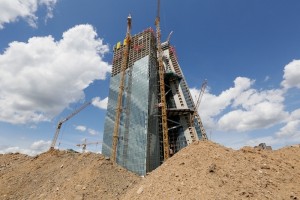Roland Tichy, one of Germany’s leading economic journalists explains why the new home of the European Central bank is laden with dubious symbolism. In his view the ECB is a powerless torso without legs. Tichy is editor-in-chief of Germany’s leading economic paper “Wirtschaftswoche” and now writes a regular column for JVG.

"Is the European currency union too big after all, attempting to unite countries whose levels of economic output are just too different?" Roland Tichy, editor-in-chief of Germany’s “Wirtschaftswoche”
In Frankfurt, a pair of enormous towers is spiraling skywards. This is to be the new home of the European Central bank, built based on an award-winning design. Yet suddenly the new building seems laden with dubious symbolism. The towers are twisted around one another, as if a giant had reached down and wrenched them out of alignment – much the same way a certain gigantic financial institution has intervened in European monetary policy, peddling unlimited credit for debt-laden states.
The ECB would love to be as powerful as the Fed in New York, but it lacks the necessary foundation – a common European State. Without a common European economic and fiscal policy, the ECB remains a torso without legs, grafted onto a European Union that it doesn’t fit and plundered by national special interests.
Tower of Babel
Other observers will see a delusion of grandeur in steel and glass, are maybe even reminded of the Tower of Babel, an undertaking that the Lord God famously doomed to fail by confusing the tongues of the workers. Is the European currency union too big after all, attempting to unite countries whose levels of economic output are just too different? And is it not characteristic that the German Jörg Asmussen is supervising the construction?
Germany was unable to secure the presidency, which had been promised them, and then failed to get the key job of “Chief Economist” as a consolation. Which job was left over for the Germans, who have by far the most robust economy in the euro zone? Construction foreman, apparently.
A grotesque image
One should be careful not to over-interpret architecture, and yet, in this case it reveals its true self – branding the sky with a grotesque image of the ill-conceived European currency union.In the coming months, the still growing concrete skeleton will be joined by a bridge over the nearby Main River.
A few meters away is the spot where the legendary emperor Charlemagne is said to have crossed the dangerous, swift-moving waters, guided safely to the other shore by a white doe.
The European Central Bank is slated to move into its new home in 2014. By then, architecture will be the furthest thing from anyone’s mind. The rescue, or demise, of the euro will be at the top of the agenda.

